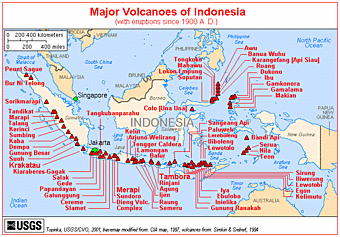Mount Agung, Bali
 Mount Agung or Gunung Agung is a mountain in Bali. This stratovolcano is the highest point on the island. It dominates the surrounding area influencing the climate. The clouds come from the west and Agung takes their water so that the west is lush and green and the east dry and barren.
Mount Agung or Gunung Agung is a mountain in Bali. This stratovolcano is the highest point on the island. It dominates the surrounding area influencing the climate. The clouds come from the west and Agung takes their water so that the west is lush and green and the east dry and barren.Gunung Agung last erupted in 1963-64 and is still active, with a large and very deep crater which occasionally belches smoke and ash. From a distance, the mountain appears to be perfectly conical, despite the existence of the large crater.
From the peak of the mountain, it is possible to see the peak of Gunung Rinjani on the island of Lombok, although both mountains are frequently covered in cloud.
The lava flows missed, sometimes by mere yards, the Mother Temple of Besakih. The saving of the temple is regarded by the Balinese people as miraculous and a signal from the gods that they wished to demonstrate their power but not destroy the monument the Balinese faithful had erected. However, over 1,000 people were killed and a number of villages were destroyed in this eruption.
There are two routes up the mountain, one from Besakih which proceeds to a higher peak and starts at approximately 1100metres and another which commences higher from Pura Pasar Agung, on the southern slope of the mountain, near Selat and which is reputed to take 4 hours. There is no path between the two routes at the top. Cecilie Scott provides an account of the ascent from Pura Pasar Agung. The mountain can be seen from various directions in video, there is a well produced video of the climb from Pura Pasar Agung and a short video from the top above Besakih. Greg Slayden describes a climb from Besakih claimed to have taken a remarkable four and a half hours to the peak and Ken Taylor describes a climb that took much longer and which included getting lost.
Guides are available in Besakih and the mountain can also be climbed without a guide. The climb from Besakih is quite tough. It is sometimes tackled as a single climb generally starting about 10.00pm for a dawn arrival at the peak and sometimes with an overnight camp about three quarters of the way up. It is far harder than the more popular Balinese climb up Gunung Batur. It is not a mountain that needs ropes and not quite high enough for altitude sickness but adverse weather conditions develop quickly and warm waterproof clothing is required and should be carried. There is no water available along the route.
Proceed through the temple complex then continue on a path that travels continuously upwards on a steep narrow spur through open forest and jungle most of the way. There is little potential to get lost until the route opens up towards the top where the correct route doubles backwards. Many climbers miss this turn and continue up a small valley which can be climbed out of with some difficulty.














 At some point in the distant past, Krakatau consisted of a single, large volcanic island. This island was destroyed in eruptions presumably of great violence, leaving three fragments of the original volcanic walls in a broken ring, or caldera, around the edge of this original island. The three islands are now named Rakata, Sertung and Panjang. Subsequently, further eruptions began, building up the largest island (Rakata) back into the center
At some point in the distant past, Krakatau consisted of a single, large volcanic island. This island was destroyed in eruptions presumably of great violence, leaving three fragments of the original volcanic walls in a broken ring, or caldera, around the edge of this original island. The three islands are now named Rakata, Sertung and Panjang. Subsequently, further eruptions began, building up the largest island (Rakata) back into the center







 Rinjani is an active volcano that built the island of Lombok along the Indonesian fault. I think that is a realistic way of looking at the role of a volcano. When anyone mentions Rinjani they always say it is on the island of Lombok. Wrong. The island is on the volcano and consequently on the tectonic plate fault line that has spawned the longest and most active line of volcanic reactions on earth. Everybody who lives on the island of Lombok owes their existence and their livelihood to the volcano. The inevitable if irregular eruptions not only created the land they stand on, but also enrich the soil for a bountiful harvest. With the tropical rains that fall on the island come the lush emerald green forests and terraced rice fields that symbolize this exotic region of Indonesia.
Rinjani is an active volcano that built the island of Lombok along the Indonesian fault. I think that is a realistic way of looking at the role of a volcano. When anyone mentions Rinjani they always say it is on the island of Lombok. Wrong. The island is on the volcano and consequently on the tectonic plate fault line that has spawned the longest and most active line of volcanic reactions on earth. Everybody who lives on the island of Lombok owes their existence and their livelihood to the volcano. The inevitable if irregular eruptions not only created the land they stand on, but also enrich the soil for a bountiful harvest. With the tropical rains that fall on the island come the lush emerald green forests and terraced rice fields that symbolize this exotic region of Indonesia.




